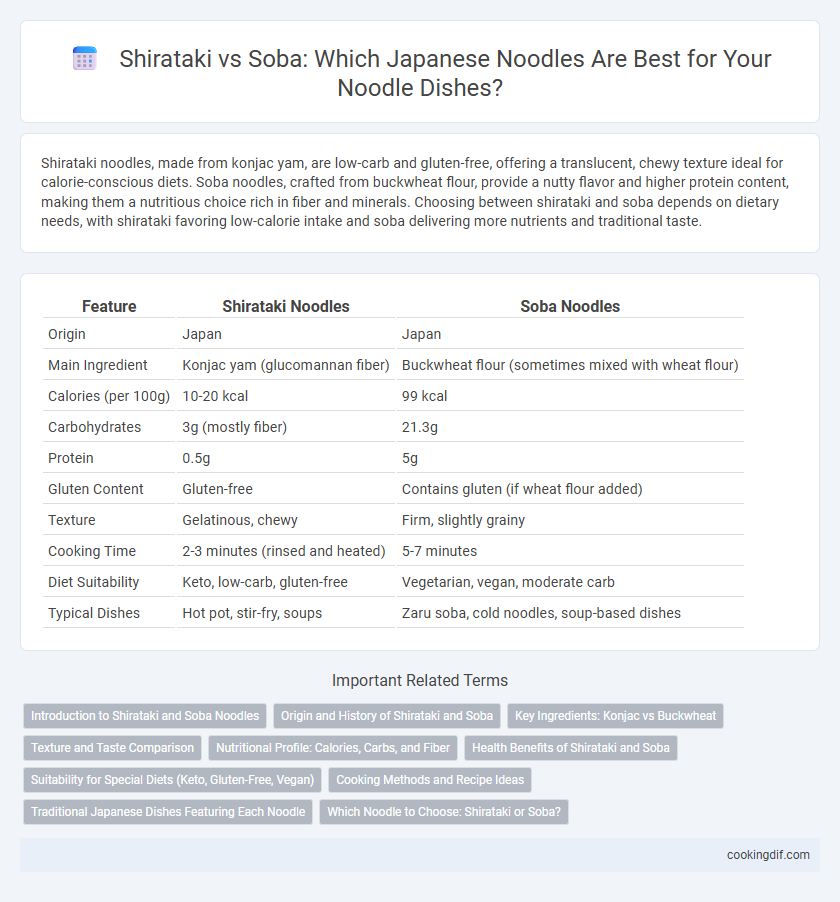Shirataki noodles, made from konjac yam, are low-carb and gluten-free, offering a translucent, chewy texture ideal for calorie-conscious diets. Soba noodles, crafted from buckwheat flour, provide a nutty flavor and higher protein content, making them a nutritious choice rich in fiber and minerals. Choosing between shirataki and soba depends on dietary needs, with shirataki favoring low-calorie intake and soba delivering more nutrients and traditional taste.
Table of Comparison
| Feature | Shirataki Noodles | Soba Noodles |
|---|---|---|
| Origin | Japan | Japan |
| Main Ingredient | Konjac yam (glucomannan fiber) | Buckwheat flour (sometimes mixed with wheat flour) |
| Calories (per 100g) | 10-20 kcal | 99 kcal |
| Carbohydrates | 3g (mostly fiber) | 21.3g |
| Protein | 0.5g | 5g |
| Gluten Content | Gluten-free | Contains gluten (if wheat flour added) |
| Texture | Gelatinous, chewy | Firm, slightly grainy |
| Cooking Time | 2-3 minutes (rinsed and heated) | 5-7 minutes |
| Diet Suitability | Keto, low-carb, gluten-free | Vegetarian, vegan, moderate carb |
| Typical Dishes | Hot pot, stir-fry, soups | Zaru soba, cold noodles, soup-based dishes |
Introduction to Shirataki and Soba Noodles
Shirataki noodles, made from the konjac yam, are low in calories and carbohydrates, making them a popular choice for ketogenic and gluten-free diets. Soba noodles, traditionally made from buckwheat flour, offer a rich, nutty flavor and are high in protein and fiber, supporting heart health and digestion. Both types of noodles hold significant cultural value in Japanese cuisine, with shirataki prized for its translucent, gelatinous texture and soba valued for its earthy taste and versatility in hot and cold dishes.
Origin and History of Shirataki and Soba
Shirataki noodles originate from Japan's traditional cuisine, made primarily from konjac yam, which has been consumed since the Edo period for its low-calorie and health benefits. Soba noodles, crafted from buckwheat flour, have a long-standing history dating back to the Jomon period and are deeply rooted in Japanese culture as a staple during New Year's celebrations. Both noodles reflect centuries of Japanese culinary evolution, with shirataki valued for its gelatinous texture and soba prized for its nutty flavor and nutritional value.
Key Ingredients: Konjac vs Buckwheat
Shirataki noodles are made primarily from konjac root, a low-calorie, high-fiber ingredient known for its gelatinous texture and ability to absorb flavors. Soba noodles, in contrast, are crafted from buckwheat flour, which offers a nutty flavor and a higher protein content, making it a nutrient-dense choice. The key ingredient differences influence not only taste and texture but also nutritional profiles, with konjac favoring low carbs and buckwheat providing essential minerals and antioxidants.
Texture and Taste Comparison
Shirataki noodles have a chewy, gelatinous texture with a neutral taste that easily absorbs sauces, making them ideal for low-calorie, gluten-free dishes. Soba noodles, made from buckwheat flour, offer a firm, slightly grainy texture and a nutty, earthy flavor that stands out in traditional Japanese cuisine. Texture-wise, shirataki is slippery and soft, while soba provides a more substantial bite, enhancing the overall mouthfeel of each dish.
Nutritional Profile: Calories, Carbs, and Fiber
Shirataki noodles contain approximately 10 calories per serving with virtually zero carbohydrates, making them an ideal low-calorie, low-carb option for weight management and blood sugar control. Soba noodles offer around 100 calories per serving, with 21 grams of carbohydrates and 3 grams of fiber, providing moderate energy and digestive benefits from buckwheat. The high fiber content in soba supports gut health, while shirataki's minimal carbs favor ketogenic and diabetic-friendly diets.
Health Benefits of Shirataki and Soba
Shirataki noodles, made from konjac yam, offer low-calorie and high-fiber benefits, supporting digestive health and weight management, while being virtually carb-free. Soba noodles, crafted from buckwheat, provide essential nutrients such as protein, manganese, and antioxidants, contributing to heart health and improved blood sugar control. Both noodles serve as nutritious options in Japanese cuisine, with shirataki excelling in calorie-conscious diets and soba delivering valuable plant-based nutrients.
Suitability for Special Diets (Keto, Gluten-Free, Vegan)
Shirataki noodles are highly suitable for keto and gluten-free diets due to their low carbohydrate content and absence of gluten, making them ideal for those managing blood sugar levels or gluten intolerance. Soba noodles, typically made from buckwheat, offer gluten-free options but may contain wheat in some blends, requiring careful label checking for strict gluten-free adherence. Both noodles are vegan-friendly, providing versatile options for plant-based diets while catering to specific dietary restrictions.
Cooking Methods and Recipe Ideas
Shirataki noodles require minimal cooking, typically just rinsing and brief boiling or stir-frying, making them ideal for quick meals and low-carb diets. Soba noodles demand boiling for about 4-5 minutes followed by cold water rinsing to retain their firm texture, suitable for chilled salads or hot broths. Recipe ideas include Shirataki stir-fries with vegetables and soy sauce or soba noodle soups with miso, mushrooms, and green onions for authentic Japanese flavors.
Traditional Japanese Dishes Featuring Each Noodle
Shirataki noodles, made from konjac yam, are integral to traditional Japanese dishes like sukiyaki and oden, valued for their gelatinous texture and low-calorie content. Soba, crafted from buckwheat flour, is essential in dishes such as zaru soba and kake soba, celebrated for its nutty flavor and nutritional benefits including high fiber and protein. Both noodles highlight unique regional culinary techniques and nutritional profiles within Japanese cuisine.
Which Noodle to Choose: Shirataki or Soba?
Shirataki noodles, made from konjac yam, are ultra-low in calories and carbohydrates, ideal for keto or low-carb diets, while soba noodles, crafted from buckwheat, offer higher protein and fiber content with a rich nutty flavor. Soba provides essential amino acids and is gluten-free when pure buckwheat is used, supporting heart health and digestion. Choose shirataki for weight management and blood sugar control, or soba for a nutrient-dense, antioxidant-rich option with balanced energy.
Shirataki vs soba for Japanese noodles Infographic

 cookingdif.com
cookingdif.com